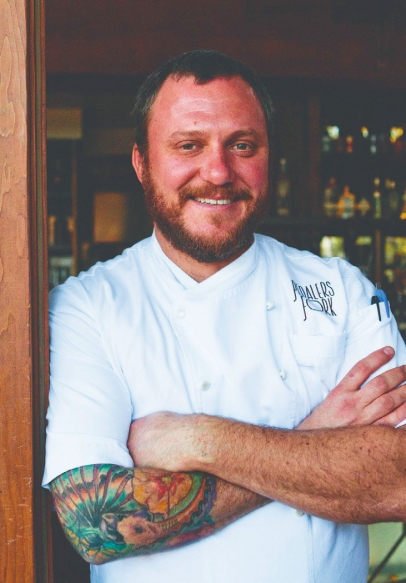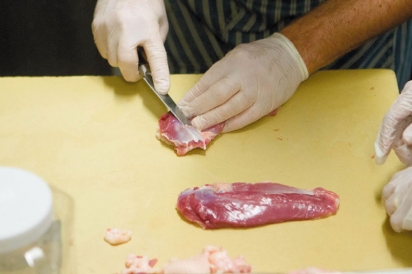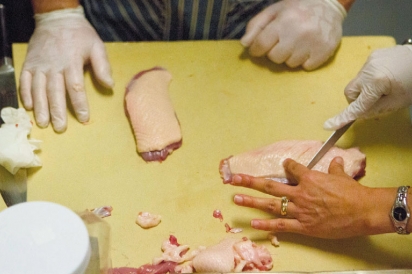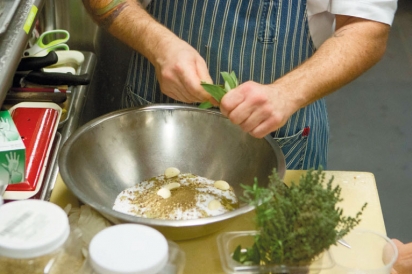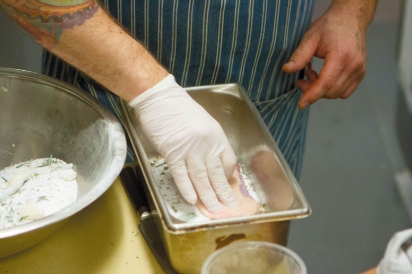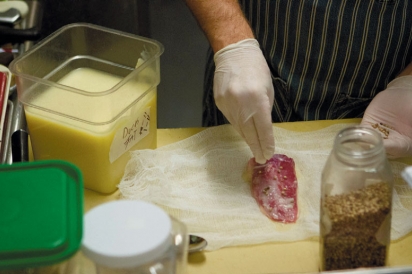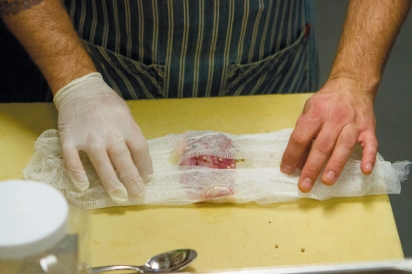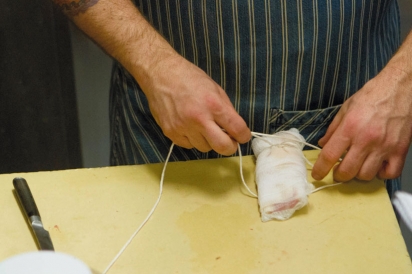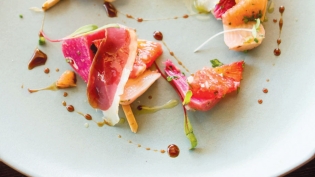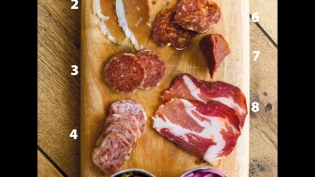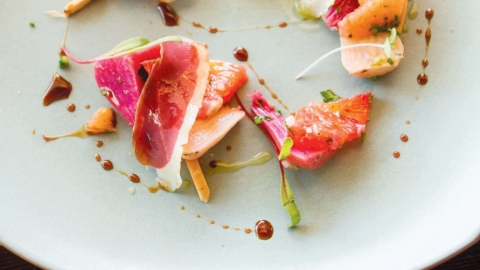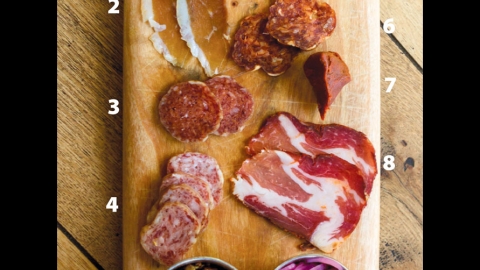An Introduction to Duck Prosciutto
Ducking into this project shows prosciutto isn’t just for pork
Sure, we cook and eat to fuel our bodies but there’s so much more to it than that. The fun comes from trying new ingredients, flavor combinations and techniques, and sharing the results with family and friends.
I look forward to the rare days when there’s not a lot going on and I can dive into a new cooking adventure. Over the years, I’ve tackled homemade Good Humor ice cream sandwich bars, fresh ricotta and homemade Twix bars, among others.
Still, I knew I was entering uncharted territory when Executive Chef Dan Murray of Pedalers Fork in Calabasas invited me into the restaurant’s kitchen to learn how to make duck prosciutto. Tucked into old town Calabasas, the restaurant serves contemporary, yet rustic, cooking with an emphasis on sourcing local ingredients, including growers here in Ventura County. Inside, reclaimed wood, high ceilings and giant panes of glass flood the bar area with natural light. Outside, a wraparound patio borders a creek beneath a lush canopy of trees.
Murray, who has been at the helm since the restaurant’s opening over two years ago, makes most of the menu from scratch, including house charcuterie—like cured pork loin, Spanish-style chorizo and bresaola (a mild cured beef ).
After training at the Art Institute of Los Angeles, Murray traveled abroad, where he got more exposure to the art of curing meats, “I had an interest early on but it was during my time in Europe that I really learned about curing and had a lot of opportunities to experiment,” he says.
The popularity of curing meat has grown with chefs and home cooks around the country tackling this ancient technique for preserving meat that dates back to the Romans.
“Curing meat is a curiously addictive hobby,” proclaims last year’s The Cook’s Illustrated Meat Book: The Game-Changing Guide that Teaches You How to Cook Meat and Poultry with 425 Bulletproof Recipes.
For cooks interested in trying their hand at home-cured meats, duck prosciutto is a good place to start, says Murray. It’s small (approximately seven ounces), has one of the shortest curing times and requires few ingredients and equipment to make, he explains. (Traditional prosciutto made with a leg of pork can take up to two years.)
Plus, the poultry version offers people who don’t eat pork or beef the chance to enjoy the cured delicacy’s lusciousness.
So I was excited to learn how to make duck prosciutto, the most unusual offering on Murray’s charcuterie board. His is sliced paper-thin with a mild, delicate flavor.
PROSCIUTTO PRIMER
To understand how prosciutto and other cured meats are made, it helps to understand the origins of the word prosciutto: It’s from Latin and means to suck out or remove [the moisture].
While the steps for curing a breast of duck are surprisingly simple, the most intimidating part for me was breasting the duck. Murray explained that it’s important to carve out the breast with very clean knife cuts since nicks and grooves in the meat can prevent the salt from fully covering the surface, allowing bacteria to form.
Using a very sharp knife to cut along the breastbone, he showed me how to follow the curve of the rib cage until you can see where the breast ends, and all that is left to cut is the skin that connects the breast to the thigh and leg. He repeated the process with the other breast. Next he removed the silver skin, scored the fat in a diamond pattern and trimmed the extra fat along the sides.
From here, the steps were pretty straightforward: Make a salt cure from sea salt, fennel, celery seed, crushed garlic, peppercorn and bay leaves. Place the breasts in a container, cover completely in the salt mixture, weigh down and refrigerate 24 hours.
During this time, the breasts dehydrate, becoming dense and turning dark red.
Remove them from the curing mixture, rinse in cold water and pat dry, cover in a layer of duck fat, wrap in cheesecloth and tie with string. Weigh and hang in the coolest part of the kitchen for about a week. Once the breasts have lost 30% of their weight, the duck prosciutto is ready to eat.
BACK HOME
Armed with Murray’s demo and instructions, I headed home to tackle my new project. I considered buying pre-packaged breasts at Bristol Farms, but they were small so I decided to purchase a whole duck.
Using my boning knife, I removed the breasts. Removing the silver skin from the breasts was a little trickier. There’s a method to this, which I haven’t quite mastered, that entails using the tip of a sharp knife and sliding it between the two ends of the silver skin and sliding it one direction until one end separates from the meat, then turning the blade back in the other direction to cut off the other end.
Murray and Michael Ruhlman, author of the books Charcuterie and Salumi: The Craft of Italian Dry Curing, both say to cure the duck for 24 hours. Since I was a little concerned about food safety, Murray suggested I keep them in the salt mixture for 48 hours.
As a result, my duck prosciutto turned out saltier than the restaurant’s. While the flavor was more reminiscent of traditional pork prosciutto I would suggest sticking with the 24-hour salt cure, which gives the meat a sweeter, more delicate flavor.
The 48-hour salt cure also fully dehydrated the duck. Although some moisture is usually lost during the 24-hour salt cure, the duck must lose another 30% of its weight in moisture during the air-drying process for the prosciutto to be considered safe to eat. In my case, the weight didn’t vary from its first weigh in after the salt cure. This made it difficult to know whether my duck prosciutto was ready and safe to consume.
The last—and most critical—step was controlling the temperature during the air-drying period. Purists recommend air-drying the meat by hanging it in a cool place with temps consistently between 50 and 65°. (Even better if they stay on the cooler side.)
That said, there’s little more unpredictable in Southern California than the weather. While I might be able to count on evening temperatures to stay at or below 60°, daytime temps can quickly jump from nippy to summery inside of a day.
Concerned about potentially exposing the duck to unsafe temperatures, I did some research and found that a wine refrigerator can be used. It offers air circulation by way of a fan, as well as temperature and humidity levels within the recommended range. (My small wine refrigerator cost about $60.)
Using the wine refrigerator provided a stable temperature and humidity environment as well as the peace of mind that I was looking for. The best part is being able to make homemade duck prosciutto year round that is lightly sweet yet rich, a little salty and perfect to serve with crusty bread and a glass of wine on a summer evening.
One more kitchen adventure to add to the list.
SURE-FIRE CURING TIPS
Here are some of Chef Dan Murray’s tips for making duck prosciutto:
Duck: Choose a male duck, which are usually larger than females.
Salt: Always use sea salt. Sea salt has naturally occurring sodium nitrite that slows the growth of bacteria, provides taste and color to the meat and inhibits rancidity.
Herbs/spices: While salt is all you really need for the salt curing step, Murray likes to “class it up a bit” by adding celery seed (also a natural source of sodium nitrite), bay leaf, fennel seed, garlic cloves and peppercorns.
Curing time: Murray cures the breasts in the salt cure for 24 hours, but if you’re concerned about food safety, he suggests brining for 48 hours.
Temperature, humidity and airflow: Purchase a thermometer with a humidity gauge. After curing in the salt, the duck breasts should hang in a cool place where the temperature does not exceed 65°. A refrigerator doesn’t provide the correct temperature range, air circulation or humidity levels needed for curing meats, but can be used for short periods of time when the ambient temperature rises above 65°, says Murray. (I did run across a recipe that cured the duck completely in the refrigerator, but I haven’t tried it.)
Mold: White mold might form on the duck during the curing process. This type of mold is safe and should be wiped away. If the meat has mold that is any other color, the curing process was unsuccessful; discard the breasts.
Deborah Pappalau is a Ventura County-based freelance writer and an avid home cook. She is the former editor of My Daily Find Conejo Valley, an online publication dedicated to food, shopping and things to do.


